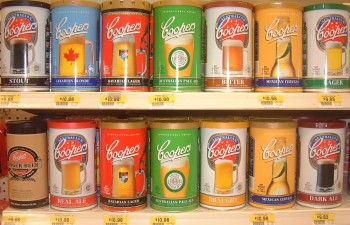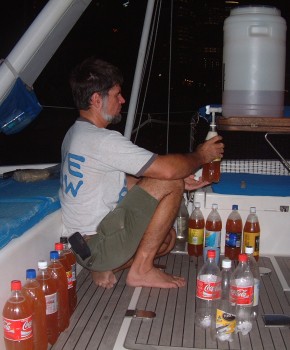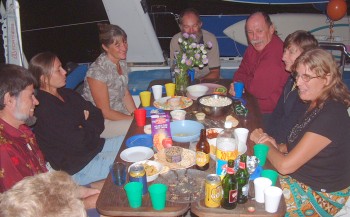
Some of the brew-kits offered by Coopers. Click on the
image to show detail & A$ prices, but we usually paid less.
Coopers Draught
We spent all of February and much of March on a road-trip around SE Australia. I obviously didn't get any brewing done, but I talked to a lot of people about it, and hopefully learned quite a bit.
 Some of the brew-kits offered by Coopers. Click on the image to show detail & A$ prices, but we usually paid less. |
Friday, 24 March 2006 - Preparation:
I decided that the overly "hoppy" taste of my attempt at Coopers
Real Ale might be
how it was intended, so I decided to try something a bit lighter. Since
I still haven't been able to find any data on the relative tastes of the
different brew-kits, I again had to go by the picture on the front of the can -
a chronically inaccurate method indeed - which eventually led to the purchase of
a Coopers "Draught" malt kit.
Instead of the Coopers Brewing Sugar (a sucrose/maltodextrin mix) we saw what Coopers extravagantly calls their "Brew Enhancer #1". This turns out to be nothing more than a dextrose and maltodextrin mix with a more grandiose price-tag. Dextrose seems to be better than sucrose for brewing (see brewing sugar discussion) so we decided to try it.
Given the problems I'd had earlier, I also bought a new valve for my bottom-fill tube. I decided that the stick-on liquid-crystal thermal strips are really the best way to continuously monitor the temperature of the wort, but I bought and installed a new one that seemed to be better calibrated. I marked this one with the optimum and absolute maximum temperatures so I wouldn't have to keep looking them up. I also took a hand thermometer to start the wort. Finally, I made a checklist of everything I'd need (copied from my brewing procedure page) and laminated it to the front of the carboy, so I wouldn't forget anything.
Saturday, 25 March 2006 - Coopers Draught:
Cleaned everything thoroughly in brewing detergent and then sterilized it in
sodium metabisulfite before rinsing everything thoroughly in cool water.
Decided not to use any hot water for the wort as even the cool tap water is
almost 80°F (27°C) which is at the high end of ideal brewing temperatures for
the yeast. Poured the can of Coopers Draught malt-kit as well as 1Kg of
dextrose/maltodextrin "Brew Enhancer #1" into the carboy and added several
liters of cool tap-water. Mixed everything thoroughly with a big spoon to dissolve it.
Added more water in ~5 liter increments, stirring continuously until I got to
23 liters. Cleaned up the work area (the laundry ashore) and brought everything
back to Ocelot. This small delay allowed the foam that had begun to
form (from pouring in the water) to settle a bit. On Ocelot, I drew off a
bit of the wort to measure the original specific gravity - 1.038.
I then opened the carboy again and sprinkled the yeast on top of the wort.
Filled the water-trap and stuck it in its hole. Set the carboy in the
cockpit to cool it slightly in the night air (time: 18:00h, temperature: ~80°F
or ~27°C) but moved it just inside the companionway when the nighttime
temperatures dropped.
|
Sunday, 26 March 2006 - Fermenting:
Fermentation started (as defined by the water-trap bubbling) after about
12 hours. Bubbling frequency built up quickly as primary (aerobic)
fermentation started, and then gradually fell-off as the oxygen was used up and
anaerobic fermentation continued (shown in the table at right). Brisbane
was beginning to cool off a bit so temperatures were generally fine, varying
between about 75-83°F (24-28°C). After no bubbles had been noticed for
several days, we decided that fermentation had come to a halt. However,
the final specific gravity was only about 1.016. This is significantly
higher than expected, and I have no real explanation at this time. Using
the specific gravity formula
for determining alcohol content, this works out to ((38-16)/7.46)+.2 => 3.15%,
which seems very low. We Shall See...
We let the wort sit for a few more days, both to allow as much fermentation to proceed as possible, as well as to allow the dead yeast to settle out as possible.
 Bottling - full bottles are at left while bottles in front of Jon are settling before being topped up. |
Thursday, 30 March 2006 - Bottling:
Because sodium metabisulfite takes some time to sterilize, I used a slightly
different procedure for sterilizing the bottles. After rinsing a bottle
thoroughly, I mixed up about half a bottle of sodium metabisulfite. Then
I'd rinse a bottle and immediately pour in the sodium metabisulfite, shaking it
up to coat the entire inside of the bottle. Only after I'd done this to
all of the bottles did I go through and rinse all the bottles thoroughly to get
rid of the sterilizing agent.
By this time, I'd worked out my mistake in attempting to prime the bottles using any maltodextrin, so I'd bought a bag of pure dextrose for priming. As before, we used 1.25 liter bottles and Amanda primed them before I filled them. My new fill-valve worked OK, but tended to leak a bit, requiring a cup be placed under it to catch drips.
Even with the bottom-filling tube, foam was generated in the bottles as I filled them, so I'd fill 5 of them as much as I could and put them aside while I filled the next one. After a minute or 2 the foam would settle back and the bottles could be topped up and capped.
So much of the dead yeast had settled-out that we were able to fill 17½ 1.25 liter bottles, yielding almost 22 liters of beer. These were stored in the bilge under the starboard aft cabin sole - probably the coolest part of Ocelot. The beer has a nice golden color, much lighter than the Real Ale but a bit darker than store-bought Draughts. The beer also responded well to the dextrose priming sugar, with the bottles becoming quite hard with carbonation, much more so than the Real Ale. I hope that there were no residual sugars from the first fermentation that hadn't fermented yet, as too much fermentation sugar can cause the bottles to explode.
 Jon's 51st birthday party celebration in Ocelot's cockpit. Jack (Naga) is hiding the beer behind the flowers. |
Friday, 7 April 2006 - Preliminary Tasting:
April 7th was my 51st birthday, so we had a bit of a party on Ocelot.
I think 7 boats came and a good time was had by all. For the celebration,
I'd chilled down 3 bottles of the new Draught and they were available for anyone
(along with 3 different wines, some fruit juice, a cola, and way
too much good nibbly-food). Since all of
the Draught disappeared, I thought that was a pretty good sign!
Even after only a week of priming, the Draught tasted surprisingly good, if I do say so myself. Nicely flavored with an interesting bitter twist at the very end. Very drinkable. I'll enjoy this one.
The head was only OK, but I expect that to improve with time. This batch is, after all, still quite green, as it's supposed to prime for at least 2 weeks and should continue to improve for several months (if it lasts that long...).
At first I thought that the bottles had primed almost too well (they were very tight) but chilling them down caused their pressure to drop quite dramatically. The tops are screwed on as tight as we think they can go, but I wonder if some of the carbonation isn't leaking out past the (used) tops. Should they be stored head-down to prevent the carbonation from escaping? But this will cause the sediment to go to the top as well. Perhaps try it on just 1 or 2, to see if that helps. But actually, their normal storage location (under the aft cabin sole) has them lying mostly on their sides, with their tops actually in the liquid, so gas shouldn't be leaking past. Maybe I'm just obsessing...
Brewing Pages:
Jon's Pages:
Top Level: Home | Destinations | Cruising Info | Underwater | Boat Guests | Ocelot | Sue | Jon | Amanda | Chris | Site Map | Make a Comment
|
If our information is useful, you can help by making a donation |
Copyright © 2000‑ Contact: Jon and Sue Hacking -- HackingFamily.com, svOcelot.com. All rights reserved.